 Kili
Type: Senegal Parrot
Genus: Poicephalus
Species: Senegalus
Subspecies: Mesotypus
Sex: Female
Weight: 120 grams
Height: 9 inches
Age: 15 years and 10 months old
|
 Truman
Type: Cape Parrot
Genus: Poicephalus
Species:Robustus
Subspecies: Fuscicollis
Sex: Male
Weight: 330 grams
Height: 13 inches
Age: 14 years, 1 month
|
 Rachel
Type: Blue & Gold Macaw
Genus: Ara
Species:ararauna
Sex: Female
Weight: 850 grams
Height: 26 inches
Age: 11 years, 9 months
|
List of Common Parrots:
Parakeets:
Budgerigar (Budgie)
Alexandrine Parakeet
African Ringneck
Indian Ringneck
Monk Parakeet (Quaker Parrot)
Parrotlets:
Mexican Parrotlet
Green Rumped Parrotlet
Blue Winged Parrotlet
Spectacled Parrotlet
Dusky Billed Parrotlet
Pacific Parrotlet
Yellow Faced Parrotlet
Lovebirds:
Peach Faced Lovebird
Masked Lovebird
Fischer's Lovebird
Lilian's (Nyasa) Lovebird
Black Cheeked Lovebird
Madagascar Lovebird
Abyssinian Lovebird
Red Faced Lovebird
Swindern's Lovebird
Lories and Lorikeets:
Rainbow Lorikeet
Conures:
Sun Conure
Jenday Conure
Cherry Headed Conure
Blue Crowned Conure
Mitred Conure
Patagonian Conure
Green Cheeked Conure
Nanday Conure
Caiques:
Black Headed Caique
White Bellied Caique
Poicephalus Parrots:
Senegal Parrot
Meyer's Parrot
Red Bellied Parrot
Brown Headed Parrot
Jardine's Parrot
Cape Parrot
Ruppell's Parrot
Eclectus:
Eclectus Parrot
African Greys:
Congo African Grey (CAG)
Timneh African Grey (TAG)
Amazons:
Blue Fronted Amazon
Yellow Naped Amazon
Yellow Headed Amazon
Orange Winged Amazon
Yellow Crowned Amazon
Cockatoos:
Cockatiel
Galah (Rose Breasted) Cockatoo
Sulphur Crested Cockatoo
Umbrella Cockatoo
Moluccan Cockatoo
Bare Eyed Cockatoo
Goffin's Cockatoo
Macaws:
Red Shouldered (Hahn's) Macaw
Severe Macaw
Blue And Gold Macaw
Blue Throated Macaw
Military Macaw
Red Fronted Macaw
Scarlet Macaw
Green Winged Macaw
Hyacinth Macaw
Glossary of Common Parrot Terms
|
As I await the arrival of my new Cape Parrot, I would like to outline some of my goals with the new bird. The order is ballpark of how it would go but not a rigid sorting:
-Get parrot, let it get used to me and new surroundings
-Develop strong flock mate/trainer relationship bond
-Encourage independent play as well as social time
-Develop a daily routine that sets feeding regimes, flight time, out of cage time, and outdoor time
-Desensitize to wide array of household objects while naming each object
-Configure clicker as bridge and eventually a strong secondary reinforcement
-Teach target training through modeling rather than trial/error if possible
-Develop strongest flight recall possible (recall by visual, whistle, and name)
-Minimum dependence on food for reinforcement
-Develop strong alternative reinforcements
-Progressive taming to allow uninhibited touch of entire body
-Make minimum intrusion introduction between Kili and Cape
-Maximum comfort harness training
-Outdoor desensitization while wearing short harness
-Begin training outdoor harnessed recall
-Socialize parrot to as many people as possible both indoors and out
-Differentiate social time and focused training time
-Develop safe petting cue and method
-Reduce beaking, biting, and nipping by ignoring
-Ignore all unpleasant vocalizations and present acceptable alternative ones
-Train necessary maintenance behaviors through positive reinforcement
-Voluntary carrier training through empowerment
-Start training full trick routine
-Goal is to train each trick in the shortest and most effective manner possible
-Develop visual and verbal cues for every trick
-Take parrot on social outings, car drives, and airplane flights while still young
-Begin implementing variable ratio reinforcement on cued behaviors
-Say same words to encourage talking
-Develop special (not annoying) contact call specific for this parrot
-Combine flight and cued tricks
-Train highly complex trick behaviors to challenge parrot
-Test cognitive capabilities through challenging puzzle tricks
-Provide occasional foraging opportunities in/out of cage
-Continue flight training optimized toward outdoor freeflight
-Perfect each trick to develop best trained parrot role model
Having extensively learned trick training on Kili and Duke, I think I will be able to train the Cape more quickly and efficiently. At the same time, I would like to experiment with alternative training methods like modeling, empowerment, and differential reinforcement. I am going to make the strongest possible effort to do all training through positive reinforcement and avoid resorting to flooding, negative reinforcement, or punishment. I do know that these methods can be effective but I am curious to accept the challenge of trying to train without them.
Here are some my goals for the trainedparrot blog:
-Provide regular updates about the Cape's progress
-Post photographs/videos of every step of training the new Cape Parrot
-Write step by step articles about how I train every single trick/behavior
-Present my thoughts/opinions about parrot ownership and care
-Develop the training blog as an alternative to costly training products
-Write objectively about the good, the bad, and the ugly
-Cite outside sources where applicable
-Lead the parrot community by example
-Make all information public and hold nothing back
-Create a definitive source of parrot training knowledge from my own experience
-Eventually open the blog up to additional willing writers
-Turn training blog posts into a complete/organized training guide
Here is a progress update about the upcoming Cape Parrot. Originally I was supposed to get the older of the two babies. Jean expected the older one to end up bigger because it was born from a larger set of wild caught parents. However, as time progressed, it turned out that the younger baby not only caught up but grew bigger than the older one. The younger Cape comes from a domestic pair named Angie and Magnum. Jean said this baby not only turned out larger but also has a sweeter disposition. The older is now 295g but the younger is 315g. They are somewhere from one to two weeks apart. Jean has done the same extensive efforts with both parrots and I am currently the only paid buyer so I have the option of choosing either one. She taught both parrots to drink from a water bottle, eat the same pellets, and to wear an aviator harness. So based on everything Jean advised, as well as all the good things I've heard from someone else that bought a Cape Baby from the same breeding pair, I decided to go with the younger/larger Cape.
This Friday, Jean will be taking the Cape to her vet on my behalf. I asked her to get the vet checks for me because she has a very good vet and I don't like the one I worked with in my area. If the parrot checks out healthy before being shipped, I don't really see any need in duplicating the check afterwards. The visual inspection the vet did when I bought Kili I can so easily do myself now at this point. I'm quite confident in Jean as a breeder so the vet check is only precautionary. The vet will also take care of some final grooming and place an open band on the parrot's left (non-dominant) foot. Pending all results being good from the vet check, Jean should be shipping the Cape Parrot to me early Tuesday morning to avoid the Florida heat. Thursday is the back up day.
Here are more pictures that I just received from the breeder:







Part of: Parrot Trick Training, Blog Announcements, Cape Parrots
Baby Cape Parrot Pictures Photos Training Blog Goals Poicephalus Fuscicollis Brown Necked Parrot |
CommentsPost Your Response
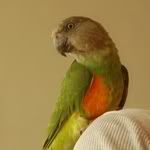
Kim S | Posted on June 10, 2010 06:35PMYou have some plans, mister... Looks good though. We should take some bets on how fast you will have your first flied recall.  They are both adorable btw.
Could you clear up a couple of points for me please?
Teach target training through modeling rather than trial/error if possible[/i:260t2x4e]
The usual trial/error would be waiting till the parrot touches the target and then click/reinforce. And not doing so when it 'misses' the target. How do you model?
Develop safe petting cue and method[/i:260t2x4e]
You're attaching a cue to 'petting time'? LIke: 'want a scratch?' and then it can expect a scratch? Or am I thinking the wrong way completely? (feeling rather blond right now)
They are both adorable btw.
Could you clear up a couple of points for me please?
Teach target training through modeling rather than trial/error if possible[/i:260t2x4e]
The usual trial/error would be waiting till the parrot touches the target and then click/reinforce. And not doing so when it 'misses' the target. How do you model?
Develop safe petting cue and method[/i:260t2x4e]
You're attaching a cue to 'petting time'? LIke: 'want a scratch?' and then it can expect a scratch? Or am I thinking the wrong way completely? (feeling rather blond right now) |
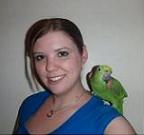
MandyG | Posted on June 10, 2010 06:57PM"Provide occasional foraging opportunities in/out of cage"
Why are you only providing occasional foraging opportunities? Usually people stress how important foraging is for parrots. |
| myakando | Posted on June 10, 2010 07:29PM[color=#0000BF:rm65v5ce]Hmmmm... I think Michael is beginning to get more and more excited about his new baby next week  [/color:rm65v5ce] [/color:rm65v5ce] |
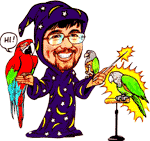
Michael | Posted on June 10, 2010 07:57PM[quote="Kim S":bc953ioz]Teach target training through modeling rather than trial/error if possible[/i:bc953ioz]
The usual trial/error would be waiting till the parrot touches the target and then click/reinforce. And not doing so when it 'misses' the target. How do you model?[/quote:bc953ioz]
You got it exactly right. Modeling would be where I leave the Cape in cage but in sight and let it watch me target Kili. Then I put Kili away and take Cape out and target it. Hopefully, if modeling works, it will grasp the concept and target without greater training effort. I will test this out to the greatest extent. If the Cape makes extensive efforts to walk over to the target stick off the first sight of it, then it was clearly modeling. If it's easier than normal to teach target but still using trial/error then modeling assisted but it still had to be taught. If modeling works well for target training, I will try to see how many other tricks I can teach simply by modeling. Basically the big difference between modeling and trial/error method is that the parrot would attempt to do the trick from the first attempt whereas trial/error doesn't work until it so happens to try the behavior for the first time.
[quote="Kim S":bc953ioz]Develop safe petting cue and method[/i:bc953ioz]
You're attaching a cue to 'petting time'? LIke: 'want a scratch?' and then it can expect a scratch? Or am I thinking the wrong way completely? (feeling rather blond right now)[/quote:bc953ioz]
You are thinking exactly right. There is a pseudo cue with Kili and I'd say this is true for most household parrots. If you pet the parrot the same way every time, your parrot can see it coming from your body language. However, with the Cape (being such a big parrot and big beak), I'd like to create a definite offer cue and a response from the parrot. So if I wiggle my fingers in preparation to scratch, if it accepts it will bend head down or otherwise reject. This is a form of empowerment that reduces aggression and prevents bites. This isn't so much for me as it is for other people that might want to handle the parrot and the benefit of my viewers. I've pet Kili whether she wanted to or not and at most she'd nip to state her opinion. However, other people have gotten bit for trying to pet her when she didn't want it. So instead, I'd like to create a very definite way of doing it.
[quote="MandyG":bc953ioz]"Provide occasional foraging opportunities in/out of cage"
Why are you only providing occasional foraging opportunities? Usually people stress how important foraging is for parrots.[/quote:bc953ioz]
The reason I only do occasional foraging is because I do a lot of training. The way I do things, training is the parrots foraging opportunity. Rather than digging/breaking treats out of some place, it has to shake its head or turn around, etc. I think it exercises much of the same brain systems as foraging and is in fact an accelerated challenge. For people who don't work with their parrots, foraging opportunities are an alternative (and possibly more natural) substitute. I don't want to encourage my parrot to look for treats on its own too much. I'd rather it look to me as a provider of treats. So the foraging opportunities are more for when I'm busy or as a supplement to training. |

HyperD | Posted on June 10, 2010 08:10PMWow Michael, you will surely be busy! I'm confident you will manage it fine.
Have there been many success stories with modelling or is it something new that you have thought to try? |

Michael | Posted on June 10, 2010 08:29PMI've heard of it used as the primary method of teaching in the Alex studies. Otherwise, not so common in parrot trick training. The reason being that it's not easy for them to model from watching us cause our limbs work differently. It's not particularly practical to use modeling other parrots for trick training unless you're trying to reteach a trick from one parrot to many because the first parrot still has to learn the tricks using the long trial/error method.
I'm just curious to see how modeling works out and to see if I can create a methodology that allows me to teach behaviors by modeling from Kili in the future. Basically I want the parrot to learn how to learn by watching Kili do it. |
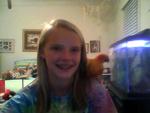
skeetersunconure | Posted on June 11, 2010 10:02PMwow good job  when you said optimize toward freeflight are you going to train them for the actual freeflight? just wondering... when you said optimize toward freeflight are you going to train them for the actual freeflight? just wondering... |

Michael | Posted on June 12, 2010 12:07AMWell I'm going to do all the flight training as though we're going to do outdoor freeflight. I will have to see how that goes and gauge our relationship/reliability before actually attempting it. Even if I never do outdoor freeflight, those skills may someday come in handy if the parrot ever gets out. |

skeetersunconure | Posted on June 12, 2010 02:57AMoh cool im really interested in freeflight but if i do it will be a long ways down the road ps im sure youve already seen this but on birdtricks it has a training entry on freeflight that explains a little bit its a good article i dont know how to insert link but here is the adress you can copy and paste http://www.birdtricks.com/AfricanGreyPa ... light.html |
| budgiebuddy | Posted on June 22, 2010 08:19PMI think your goals sound great. |
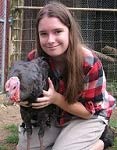
TheNzJessie | Posted on June 23, 2010 11:37AMyour going to freeflight outside??? or did i read your post wrong???? |

Michael | Posted on June 23, 2010 12:36PMI said train toward outdoor freeflight. I'm doing the same with Kili. This doesn't mean I will outdoor freefly either parrot but I want them to be proficient and reliably enough that I would feel comfortable getting them back if they got out of the house or off the harness. If someday I find that the birds are well trained enough for outdoor freeflight, I might consider it. As of now though, I definitely don't think Kili is reliable enough for it. However, the Cape being never clipped might have a better chance but we'll see. It's just icing on the cake and I won't be too disappointed if it never happens.
Warning, outdoor freeflight is a very risky business, please do not attempt it on your own. |
Post Your Response
|








 Previous Article
Previous Article Next Article
Next Article 
